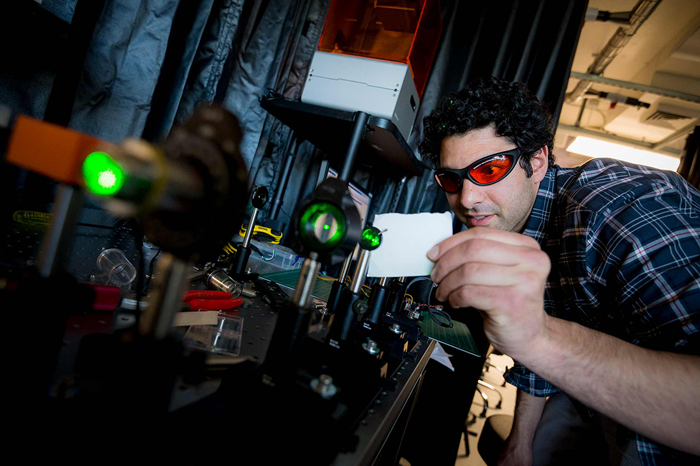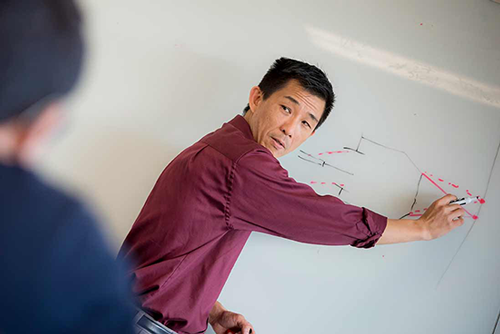Hacking a Revolution in Biology
Graduate students in new quantitative biology doctoral program learn to modify microscopes and other instruments to probe frontiers of their emerging discipline
November 10, 2016
By Kim McDonald

Photos by Erik Jepsen/UC San Diego Publications
Graduate studies within any single scientific discipline are challenging endeavors on their own. But imagine combining graduate school-level training in physics and mathematics with advanced research in engineering and biology.
That’s the challenge of a new graduate program at UC San Diego that’s teaching Ph.D. students how to combine the power of physics and math-based reasoning with practical engineering skills and biology in an effort to unravel the fundamental principles of living systems—principles that will likely encompass concepts reaching well beyond those of traditional biology.
The goal of this ambitious program is to develop a new generation of scientists who are simultaneously fluent in biology, physics, mathematics and engineering. The program aims to train scientists who can not only develop instruments capable of quantifying the behaviors of living organisms but also develop and experimentally test their own theories based on these data. These young scientists are to be the foundation of an emerging discipline known as “quantitative biology”—or “qBio.”

Biophysicist Philbert Tsai directs the Hacker Lab
According to a recent National Academy of Sciences report, advances in quantitative biology are critically important in order for our nation to continue to make future progress in medicine, genetics and the life sciences.
“In quantitative biology, we’re applying the quantitative approaches that physicists and chemists have successfully used to discover order in the physical world, to unravel the complexity of the biological world,” explained Terry Hwa, a UC San Diego professor of physics and molecular biology. “Our goal is to turn biology from a descriptive science into a predictive science, so that in the future we can manipulate biological organisms like the way we currently design airplanes, using wind tunnels and mathematical modeling, instead of just by random trial and error.”
“Quantitative biology is the next revolution in biology,” said Jeff Hasty, a UC San Diego professor of molecular biology and bioengineering. “There’s little doubt that all of biology will be quantitative in 20 to 30 years. We need fundamental principles. We need to get people thinking about biological systems the way engineers think about circuits or the way astronomers think about how stars move around.”
UC San Diego’s innovative qBio doctoral program launched last fall with an initial class of 10 graduate students, followed by another 10 students this fall. The program is the central feature of the campus-wide quantitative biology initiative, which involves more than 30 faculty members from biology, chemistry, engineering, mathematics, physics, and the UC San Diego School of Medicine. Co-directed by Hwa and Hasty, the campus-wide program is one of a number of new forward-thinking research initiatives at UC San Diego designed to make the university a world leader in key areas of future importance to society.
While a number of other campuses across the country have recently initiated quantitative biology research and teaching programs, UC San Diego’s qBio graduate program is unique in one important way: Graduate students spend a year in the program’s “Hacker Lab” on the 6th floor of Urey Hall. There they take apart sophisticated microscopes and other state-of-the-art research equipment and put them back together in novel ways. This hands-on “hacker” experience provides them with the engineering skills to modify instrumentation in a way that permits them to solve research problems that can’t be addressed with off-the-shelf equipment.
“In biology, scientists generally use equipment they get from vendors that’s designed for the broadest possible use,” said Hwa. “But if you’re at the cutting edge of research, you need to probe questions no one else has looked at before. For that reason, the students with the ability to modify instruments to suit their specific research needs will have a distinct advantage.”

Graduate students use lasers and optics to understand the principles of microscope design
Within the Hacker Lab, which is being operated and taught by biophysicist Philbert Tsai, the graduate students initially learn about skills such as basic computer-to-hardware interfacing, 3-D printing and design, microfluidic devices and state-of-the-art microscope technology. They then apply that knowledge to modify and build instruments in quarter-long projects of their design that allows them to view biological processes that can’t be seen by standard instruments or requires them to overcome some other limitation of existing instrumentation.
It’s a requirement that fits with the tradition of UC San Diego: Graduating students who not only think differently, but have the skills to push the envelope of their fields in non-traditional ways by taking things or ideas apart and putting them back together in novel ways.
“We want to train the next generation of scientists to be capable of operating completely independently,” said Hasty, “so they could attack problems in which the questions aren’t even well defined.”
Quantitative Biology Graduate Program website and video at: https://qbio.ucsd.edu/
